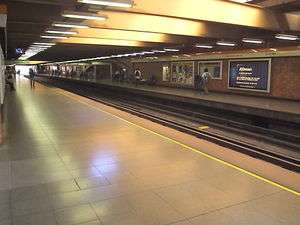Santa Ana metro station
| Santiago Metro station | ||||||||||||||||
 Santa Ana station on the Line 2. | ||||||||||||||||
| Coordinates | 33°26′17.35″S 70°39′35.69″W / 33.4381528°S 70.6599139°WCoordinates: 33°26′17.35″S 70°39′35.69″W / 33.4381528°S 70.6599139°W | |||||||||||||||
| Line(s) |
| |||||||||||||||
| Platforms | 2 side platforms at each line | |||||||||||||||
| Tracks | 2 per line | |||||||||||||||
| Connections | Transantiago buses | |||||||||||||||
| Construction | ||||||||||||||||
| Disabled access | Yes | |||||||||||||||
| History | ||||||||||||||||
| Opened |
September 15, 1987 (Line 2) March 2, 2000 (Line 5)[1] | |||||||||||||||
| Services | ||||||||||||||||
| ||||||||||||||||
Santa Ana is a transfer station between Line 2 and Line 5 of the Santiago Metro. It was initially a single-line station on Line 2, subsequently in 1998, the station began to be adapted to become a transfer station, as a part of the extension of Line 5 from Baquedano metro station to Santa Ana station, in which the New Austrian Tunnelling method was used.[1]
The older portion of the station occupies part of the central reservation of the Autopista Central, which is sunken. Two street-level mezzanines at the northern and southern extremes of the station are connected with bridges traversing the highway.
The station receives its name from the nearby Santa Ana church.
References
- 1 2 "Historia" [History]. Metro de Santiago. September 30, 2015.
This article is issued from Wikipedia - version of the 10/18/2015. The text is available under the Creative Commons Attribution/Share Alike but additional terms may apply for the media files.